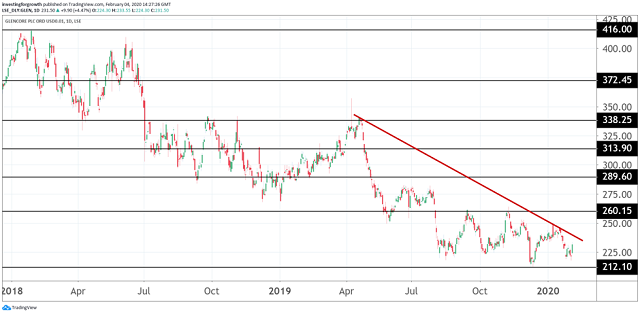Beat-up Glencore shares bounce back
Having halved in value over two years, there was a rare glimmer of hope in this production report.
4th February 2020 14:40
by Graeme Evans from interactive investor
Having halved in value over two years, there was a rare glimmer of hope in this production report.

The frayed nerves of Glencore (LSE:GLEN) investors were calmed a little today when the large cap commodities giant offered signs of an improved operational performance in Africa.
Shares surged 5% following the 2019 production update, although it's a rally set against a long period of underperformance compared with the likes of Rio Tinto (LSE:RIO) or BHP Group (LSE:BHP).
The share price is still only 232p, which is roughly where the blue-chip stock has languished since last August's half-year results, when Glencore revealed a 32% decline in earnings.
The performance last summer highlighted continued operational difficulties from its Africa copper business, with an expected cobalt boom from the metal's use in batteries for electric cars still to materialise due to oversupply causing a 40% slide in prices.

Source: TradingView Past performance is not a guide to future performance
There have been several other reasons for the share price weakness, many of which relate to its operations in the Democratic Republic of Congo (DRC). This included a request from the US Department of Justice in 2018 to produce documents relating to compliance with the Foreign Corrupt Practices Act in DRC as well as Nigeria and Venezuela.
It also had to untangle a dispute involving Israeli billionaire Dan Gertler that had threatened to disrupt supplies of cobalt. These issues have proved a deterrent for many investors, with mining analyst John Meyer at SP Angel highlighting this point in an interview with interactive investor in December.
He said:
“I like Glencore as a company, but it operates in some quite risky areas, and some of that risk has been proven. And although they have fantastic production discipline that also can work against them in a declining market.”
- Mining stocks: Tips for 2020
- 11 shares that could cut their dividend in 2020
- ii Super 60 investments: Quality options for your portfolio, rigorously selected by our impartial experts
Glencore was still the 12th most-bought stock among ii clients last year, but the fact that it was also the second most-sold suggests that some of this trading activity was speculative.
There was reason to jump back onboard today after an improved performance from Glencore's Katanga copper mine in DRC. Production of cobalt, which is a by-product of copper mining, surged 10% due to the ramp-up of activities at the same site.
This helped to offset last year's move to halt production at Glencore's Mutanda mine, which is the world's largest cobalt facility. Glencore took the decision due to the site being made unviable by the falling price, as well as rising costs and additional mining taxes.
Analysts at Morgan Stanley described Glencore's overall Q4 performance as mixed after it beat estimates for copper output but missed targets in coal, nickel and coal. Copper and coal account for more than 50% of the company's underlying earnings.
The bank reiterated its “overweight” rating and 262p price target, based on factors including the company's diverse commodity mix and prices still below long-term sustainable levels.
BMO Capital Markets analyst Edward Sterck is more cautious about the near-term outlook, particularly as the African copper assets continue to face operational challenges. However, he added:
“We think the outlook for most of Glencore's commodities should improve as 2020 progresses and will be looking for operational improvements to give confidence in the outlook.”
Glencore joined the London stock market at a price of 530p in 2011 but has not tested that level since. The stock had been trading at close to 400p this time two years ago.
These articles are provided for information purposes only. Occasionally, an opinion about whether to buy or sell a specific investment may be provided by third parties. The content is not intended to be a personal recommendation to buy or sell any financial instrument or product, or to adopt any investment strategy as it is not provided based on an assessment of your investing knowledge and experience, your financial situation or your investment objectives. The value of your investments, and the income derived from them, may go down as well as up. You may not get back all the money that you invest. The investments referred to in this article may not be suitable for all investors, and if in doubt, an investor should seek advice from a qualified investment adviser.
Full performance can be found on the company or index summary page on the interactive investor website. Simply click on the company's or index name highlighted in the article.